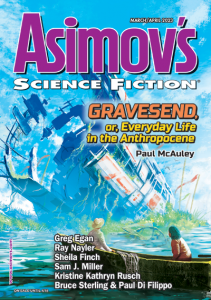Karen Burnham Reviews: Analog and Asimov’s
The lead novella in the March/April Analog is ‘‘The Tinker and the Timestream’’ by Carolyn Ives Gilman. Rustem is a young man learning to be the tinker of his colony, which is tenuously living under the threat of a solar eruption wiping them out at any minute. Interstellar travelers arrive, traveling in a fascinatingly complex way involving time currents and bubbles of slow vs. fast time. Firni, a neurodivergent young woman from the colony, goes with the aliens and hijacks Rustem to come along – they’re hoping to find a new world nearby to move to. But of course when traveling involves complicated time machinations, you never know if you’ll find what you need in time. ‘‘Ice Ageless’’ by Rajnar Vajra features Solomon, a starship pilot invited to help save humanity. He will act as the sole pilot for a 10,000-year journey to bring frozen colonists to a new star system. He’ll have a vastly slowed-down metabolism so that from his perspective the journey will take ten sleepless subjective days. It felt similar to the torturous piloting required in some of Cordwainer Smith’s stories (cf ‘‘The Lady Who Sailed the Soul’’ [1960]). The descriptions of Solomon’s experience is intense and hallucinogenic; I wish there’d been a bit more denouement to let us know if it was all worth it. Speaking of an older generation of SF writers, Allen M. Steele has a novelette, ‘‘The House on Infinity Street’’, that’s a love letter to the ’30s/’40s generation of writers. He’s narrating a story as if told to him by ‘‘Shelby Weinberg’’ (can’t help but think that’s a shout-out to one of my favorite foundational SF writers, Stanley G. Weinbaum). Taking off from the old Harlan Ellison joke about ordering his ideas from a place in Schenectady, in this case you really could get ideas from a mailing address in Deerfield, Massachusetts. In exchange for a cut of the story sale, you’d be sent an idea that seems strikingly reminiscent of our 21st-century technology. Shelby and a companion get curious and set up a stakeout of the Deerfield post office. Hijinks ensue, it’s a fun story.
In the subgenre of relativistic warfare stories, ‘‘Aalund’s Final Mission’’ by Raymund Eich is a solid entry. A ship on a military mission has been accelerated to near-C by lasers at their origin point. Their plan to drop a wormhole on an enemy installation depends on lasers on the other side slowing them down – but they get late word that the laser installation has been overrun, and they won’t be able to decelerate. After investigating all possible options, the captain suggests that surrender is their best hope for ending their lives as something other than a relativistic comet – but the political officer does not agree. The climax is well done. Sanyah Allani is a much more reasonable security officer in ‘‘Death Spiral’’ by Kate MacLeod. She works on a mining asteroid shared between humans and ant-like aliens referred to as ‘‘stigmergs.’’ The human crew is all female because there’s something about human male pheromones that interrupts the chemical communications of the aliens. Things seem to be increasingly unsettled when Sanyah befriends the orphan Rosia, who takes her to an area where various family members have been smuggled on board. Rosia is also key to the solution when the aliens start swarming in ways harmful to both humans and themselves. It wraps up nice and neatly.
Asimov’s leads off with Kristine Kathryn Rusch’s novelette ‘‘The Nameless Dead’’. In a new perspective on a fairly old plot, our narrator is a woman filled with self-loathing after abandoning her husband and baby to take a one-way relativistic journey. She washes up on a waypoint station and carves out a life helping people track down information about the ones they left behind. Eventually the retiring coroner hires her to help track down various John and Jane Does, people who had languished for years unidentified. In the course of her investigation, we learn that many people made this trip involuntarily, which puts a very different spin on the narrator’s inherent cynicism. Ray Nayler brings us ‘‘The Case of the Blood-Stained Tower’’, where, in a city at the crossing of Silk Road-era trade routes, a princess seems to have been murdered by being thrown from the top of the Great Mosque. The narrator was gravely wounded in battle and after being rescued becomes scribe to Qadir, who travels with Knud. Qadir is asked to investigate the strange case, which inevitably leads them down some strange paths, which includes areas where different times can collide, reminding me of the ‘‘soft spaces’’ from Neil Gaiman’s Sandman series. The whole story is satisfyingly Holmesian, and I for one would be happy to read more of this setting and character (cf also Lavie Tidhar’s ‘‘Judge Dee’’ series at Tor.com). Taking inspiration from a different historical era, ‘‘Ernestine’’ by Octavia Cade features the title character trying to survive in a world where everyone over the age of 18 has disappeared in almost literally a puff of smoke. Trying to avoid bands of feral kids smashing up stores to get whatever they need, she holes up in the cloakroom of a science building – the room where Ernest Rutherford did his structure-of-the-atom experiments. She meets and befriends his ghost, but instead of recounting his atomic research days, he is very firm on the importance of growing your own food, especially potatoes. Full of tidbits from Rutherford’s biography, it’s also a solidly done survival story for our heroine.
Sam J. Miller brings us a deeply felt comedy in ‘‘Planetstruck’’ starring Aran, a cheerful gay sex worker and intelligence operative. His homeworld had been cut off from the galactic web of instant teleportation portals right after he left, thanks to anti-offworlder terrorists. But in the course of his work, he finds evidence that there might still be a route home. He enlists two mercenaries with whom he’d shared some intensely pleasant busman’s vacation time to help him track down the man who might hold the key to his homeworld – which opens up a completely different scale of choices for him. In ‘‘Night Running’’, Greg Egan imagines the consequences of a drug that lets you do relatively mundane things while essentially sleepwalking – you wake up feeling mentally refreshed, but you’ve gotten something done while your mind rested. Luke decides to try it while working on a seemingly unsolvable problem at his geology job. The results after only a week are positive but concerning (he wakes up miles from home after a very long run in the middle of the night) and stops taking the drug – but the effects linger. He tries all manner of ways to keep his sleepwalking self from leaving his apartment, each more complicated than the last. I kept expecting some of the subplots to be fleshed out more, such as the unsolvable problem or the romance that his sleepwalking self-initiated, but the eventual solution to Luke’s problem is humane and reasonable. The issue ends with an oddly lovely novella by Paul McAuley, ‘‘Gravesend, or, Everyday Life in the Anthropocene’’. Rose is discharged from the army after an encounter with a psych bomb leaves her with lasting trauma and occasional intrusive hallucinations. She washes up in a commune of almost hippie-ish ‘‘oldsters,’’ who are making a living in a hot and humid marsh near the mouth of the now-flooded River Thames. Rose is attracted by rumors of ‘‘soul chips’’ and a man who inherited his séance-giving aunt’s house who might be looking for them. She meets him and that sets off an unexpected path of investigation – he doesn’t particularly care about them, but someone does, enough to steal ones from his house whenever his aunt’s projection system for the housed AI ‘‘souls’’ is turned on. Rose dreams of finding someone to buy the remaining stash and get enough money for treatment at a clinic in the Czech Republic rumored to be able to actually cure people with her kind of trauma. But is that the way of life in the Anthropocene? The ending is all the more satisfying because it isn’t pat.
Recommended Stories
‘‘Aalund’s Final Mission’’, Raymund Eich (Analog 3-4/23)
‘‘The Tinker and the Timestream’’, Carolyn Ives Gilman (Analog 3-4/23)
‘‘Gravesend, or, Everyday Life in the Anthropocene’’, Paul McAuley (Asimov’s 3-4/23)
‘‘The Case of the Blood-Stained Tower’’, Ray Nayler (Asimov’s 3-4/23)
Karen Burnham is an electromagnetics engineer by way of vocation, and a book reviewer/critic by way of avocation. She has worked on NASA projects including the Dream Chaser spacecraft and currently works in the automotive industry in Michigan. She has reviewed for venues such as Locus Magazine, NYRSF, Strange Horizons, SFSignal.com, and Cascadia Subduction Zone. She has produced podcasts for Locusmag.com and SFSignal.com, especially SF Crossing the Gulf with Karen Lord. Her book on Greg Egan came out from University of Illinois Press in 2014, and she has twice been nominated in the Best Non-Fiction category of the British SF Awards.
This review and more like it in the May 2023 issue of Locus.
 While you are here, please take a moment to support Locus with a one-time or recurring donation. We rely on reader donations to keep the magazine and site going, and would like to keep the site paywall free, but WE NEED YOUR FINANCIAL SUPPORT to continue quality coverage of the science fiction and fantasy field.
While you are here, please take a moment to support Locus with a one-time or recurring donation. We rely on reader donations to keep the magazine and site going, and would like to keep the site paywall free, but WE NEED YOUR FINANCIAL SUPPORT to continue quality coverage of the science fiction and fantasy field.
©Locus Magazine. Copyrighted material may not be republished without permission of LSFF.






